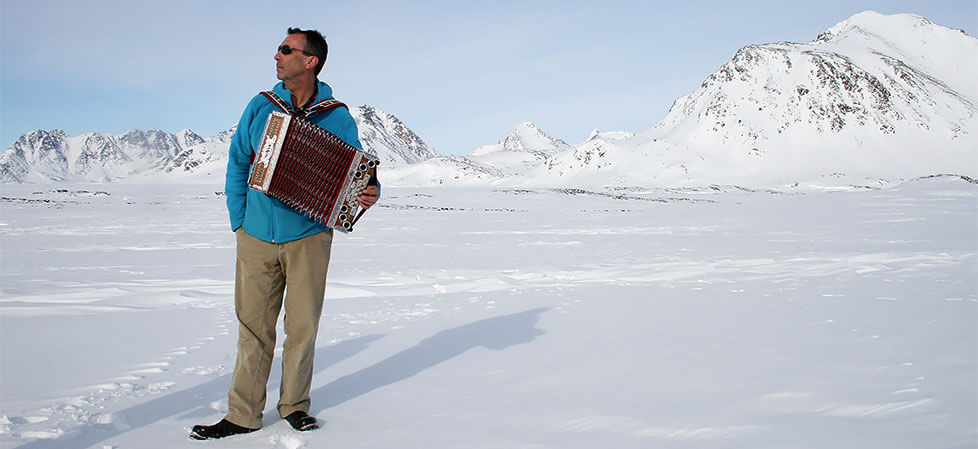HvG IN GREENLAND
Beyond sound: Goisern in Greenland

Since the hit "Brenna tuat's guat" Hubert von Goisern has been celebrated as a star again at home. The musical world explorer travelled to Greenland for the second time at the end of March - to an almost uninhabited vastness and social tristesse.
Not a note is hit. Hubert von Goisern sings an A again. He gets a lot back from the 20 schoolchildren - but no As. Hubert von Goisern doesn't like playing the teacher. He likes playing music, likes listening to stories, exchanging. It's difficult. Language above all else separates him from from the children in the school in Sermiligaaq. And so as the children try singing, it sounds as though this problem in East Greenland can't be solved with music.
It takes half an hour in the helicopter to fly to Sermiligaaq from Tasiilaq. The helicopter takes ten minutes to there from the island of Kulusuk, and you fly to Kulusuk from Iceland in a jet in a good hour and a half. "You're so much in nothingness", says Hubert von Goisern. There's a tiny supermarket. The school is used as a church too. Visitors are quartered with the locals. The loo is a bucket. There's no running water, there are no streets either, only narrow footpaths lead through deep snow across the small peninsula. There are 50 houses here. 15 of them are uninhabited. Officially there are 215 people living here - and 100 huskies. Sermiligaaq has been stirred up because of one of these dogs: the team from the village has won a championship. A party is planned for when the team returns from a one day journey across the frozen fjord. "Pisaaneq!", cheer the residents, "we're the best!" There's seldom anything to celebrate here.
His own curiosity and Robert Peroni are what have brought Hubert von Goisern to East Greenland. Peroni fell in love with the country on a tour across the ice sheet and he runs the Red House in Tasiilaq. It's a lodging house for adventurers and tourists and a kind of social project.
Peroni employs only natives and gets involved with young people, whose situation is particularly hopeless: no work, lots of alcohol, high suicide rate.
Peroni was looking for someone else who "gets involved with foreign culture and who could perhaps open a new perspective for young people" - and he found the Goiserer. He came into "something completely unfamiliar". It is a difficult undertaking. The people are shy. There are few points of contact.
In Sermiligaaq only Uinaat Uitsatsikitseeq, the teacher, speaks a bit of English. When he translates, it usually takes three times as long as what Hubert von Goisern says. The ice is broken when Hubert von Goisern unpacked long-buried sounds. He is well prepared.
"What I see in him is that people interest him and that he takes his time", Peroni says of the Goiserer, who visited Greenland for the first time last September. "The requirement for understanding this kind of the unknown is giving yourself up to it with every openness", he says, but corrects himself straightaway: "Well, you can't understand it completely, but you can try."
Hubert von Goisern plays recordings of old Inuit singing on his laptop, recorded in the region in the 1920s by the Danish ethnologist Knud Rasmussen. They are Shaman drum dances and songs that developed in a kind of competition concerned with holding one's opponent up to ridicule in song - comparable with the gstanzls of the alpine region or rap battles: sung conflict settlement.
There are only a few "artistic" traces in the history of the Inuits. The hardness of a region of ice and a short summer, as well as the constant fight for survival offer space for little more than surviving. The half-nomadic people had to master the modern trend in just a few decades. Traditions passed down through the generations were left behind. "Now the children are learning languages and arithmetic and other things with which they basically can't do anything in the hard surroundings", says Hubert von Goisern.
While the old recordings are playing, a few students start to sway in time. They are movements that you can see in the old films of Knud Rasmussen. No, nobody does that any more, says one of the students. They've never heard it before, but they know who it is, the great grandfather of that person and that. And the uncle of someone they knew wrote the song.
Hubert von Goisern plays two concerts - alone, with just guitar or accordion. One in Forsamlingshuset in Sermiligaaq, one in a bar in Tasiilaq. The audience gets moving whenever he unpacks his accordion. There's a touched atmosphere during the yodels, as if the listeners recognise something familiar.
In Tasiilaq the Goiserer met the school band. They play him a few songs - including one by the Greenland band Nanook. Nanook allow Greenland traditions to be heard in some songs. The Goiserer wants to know from the students whether they would put Greenland influences into their music. They answer politely that they wouldn't. But they look as though they want to say: how could you think of doing such a thing?
They play the rock music that the satellite dish brings into their houses. It is the music of unreachable distance. The school band plays Knockin' on Heaven's Door. Hubert von Goisern picks up the accordion and joins in. The Dylan song proves itself to be a universal language. For one song the differences are put aside.
A few days previously, in Sermiligaaq, something else came from a musical confusion: the Andachtsjodler. Or at least a rough draft. Then Hubert von Goisern says that he is flying home now and that he will return. The students listen to the translation, stand up and all hug him. "It's a start", says the Goiserer. But it needs "time, the continuity that creates trust." He is planning the next journey for the winter.
